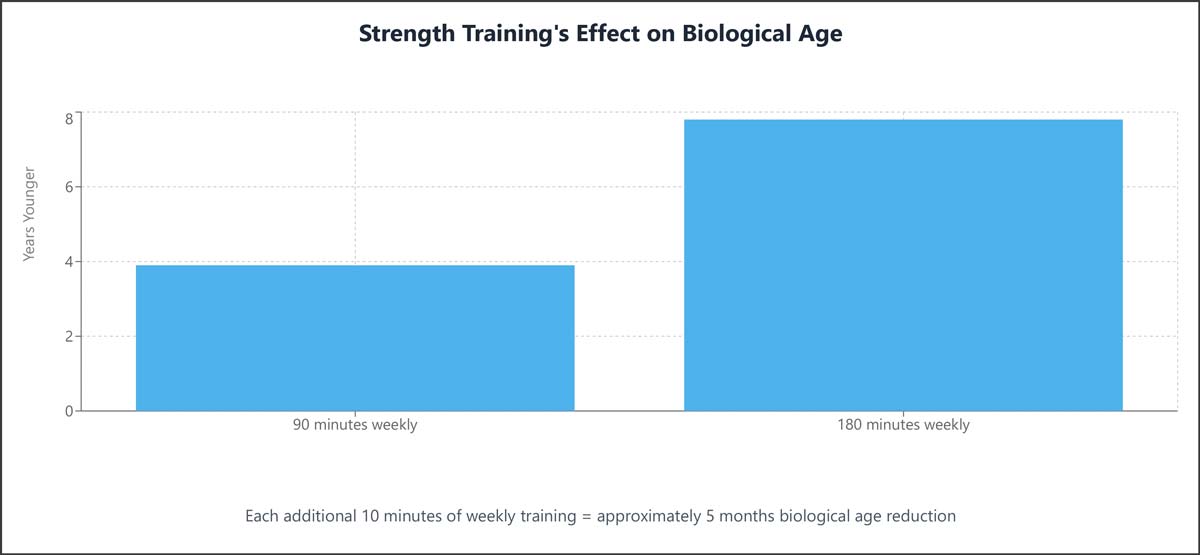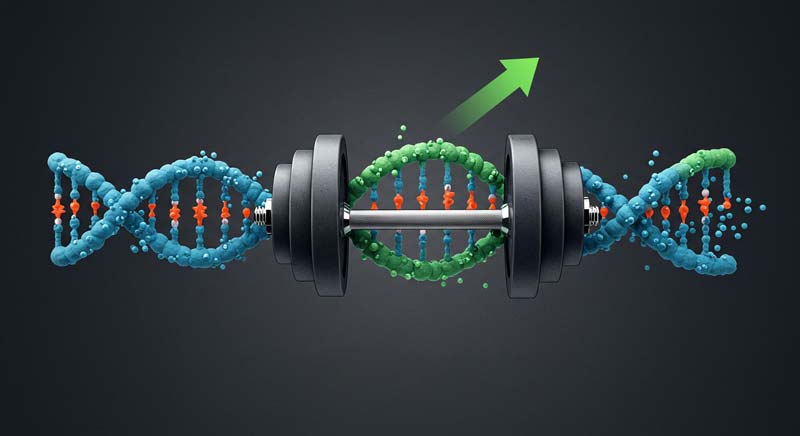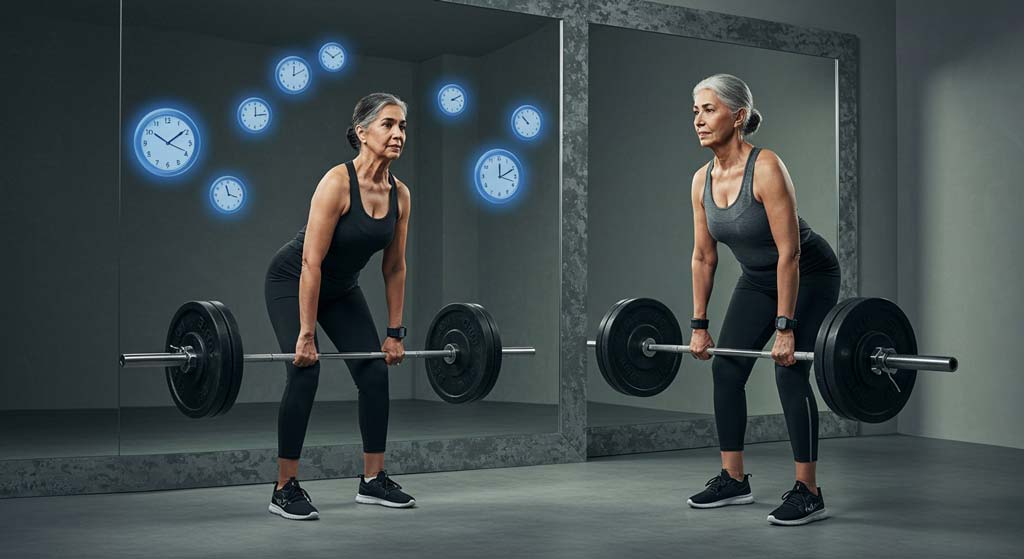Strength training makes you younger is more than just a catchy headline—it’s a scientific reality supported by groundbreaking research into our body’s ageing process. This fascinating connection operates at our fundamental biological level, where exercise influences the structures that control how our cells age.
The relationship between physical activity and ageing has long intrigued scientists. Still, recent research has uncovered remarkable evidence about how resistance exercise affects our cellular timekeepers. These molecular clocks, known as telomeres (protective caps at the end of our chromosomes), play a crucial role in determining our biological age—distinct from the years shown on our birth certificates.
Global health data paints a sobering picture: over 17 million lives are lost annually to cardiovascular diseases, with physical inactivity being a major contributor. However, evidence suggests that simple lifestyle changes, particularly incorporating strength training, can make you younger through cellular adaptations that can significantly impact your health span—the portion of your life spent in good health. This simplicity gives hope and motivation for a healthier, younger future.
The science behind this age-defying effect involves multipart biological processes, yet its practical applications are surprisingly straightforward. From the molecular changes in our muscle tissue to how our bodies manage inflammation and stress, strength training creates beneficial adaptations encompassing muscle growth, metabolic health, and cellular regeneration.
This post examines the scientific evidence showing how lifting weights influences biological age through cellular mechanisms. I’ll analyse the relationship between strength training and telomere length, uncover the biological pathways that control aging, and reveal why resistance training is a powerful tool for maintaining cellular youth.
Understanding Telomeres: Your Body’s Age Calculator
Think of telomeres as the protective caps on your shoelaces—except these caps safeguard something far more precious: your DNA. These microscopic structures serve as biological timekeepers, gradually shortening each cell division and effectively marking the passage of time in our bodies.
As we age, these protective caps naturally become shorter, much like a burning candle gradually decreases in length. This process affects every cell in our body, from skin to muscle tissue. Research indicates that individuals with longer telomeres typically display better health outcomes and enhanced longevity. This highlights how strength training makes you younger through cellular mechanisms.
The relationship between telomeres and aging involves multiple biological processes. These structures actively influence our cells’ ability to function and regenerate. When telomeres become critically short, cells enter a state called senescence (cellular retirement), where they stop dividing and can trigger inflammation throughout the body. However, lifestyle factors, including strength training, which makes you younger, can significantly influence this process.
Scientists have discovered that telomere length varies amongst different populations, with women typically possessing longer telomeres than men. Fascinatingly, those who reach exceptional ages, such as centenarians, often maintain better telomere length than others in their age group, suggesting that telomere preservation plays a crucial role in longevity.

Key Study Findings on Strength Training Makes You Younger
For instance, the research demonstrated that incorporating strength training into your weekly routine can make you younger through measurable changes in telomere length. Each 10-minute increase in weekly strength training showed cellular improvements equivalent to slowing ageing by about five months. This means that even a slight increase in strength training can significantly impact your cellular age.
This cellular benefit accumulates meaningfully over time. Adults who dedicated 90 minutes weekly to strength training showed cellular patterns indicating nearly four years of reduced biological aging.
When analysed against natural ageing patterns, telomeres typically shorten by 15.47 base pairs annually, translating to a remarkable 3.9 years of reduced biological ageing. Moreover, those who engaged in strength training were made younger for 180 minutes weekly and demonstrated cellular patterns equivalent to 7.8 years younger.
The research identified consistent benefits across diverse populations, regardless of age, sex, or ethnicity. This means that no matter who you are, incorporating strength training into your routine can help you maintain cellular youth.
These findings align with broader research showing how resistance exercise influences cellular health through multiple pathways. Regular strength training triggers beneficial changes in muscle tissue through mechanical stress.
The research revealed additional significant health impacts:
- Metabolic Benefits: Strength training increases resting metabolic rate by approximately 15%.
- Cardiovascular Protection: Regular resistance exercise reduces systolic blood pressure by about 6.0 mm Hg.
- Muscle Preservation: Participants maintained and increased muscle mass even into their tenth decade.
- Fat Reduction: Strength training significantly decreases visceral fat, which is particularly important for metabolic health.
- Oxidative Stress: Regular training enhances the body’s natural antioxidant defences, protecting cells from damage.
The Science Behind How Exercise Affects Aging
At the cellular level, strength training makes you younger through multiple intricate biological mechanisms. These processes enhance our body’s natural repair systems and combat age-related decline.
Understanding Our Cellular Power Plants
Mitochondria (tiny structures that produce energy in our cells) naturally become less efficient as we age. This decline affects everything from our energy levels to how well our tissues repair themselves. When we engage in resistance training, these cellular powerhouses respond remarkably. They increase both in number and efficiency, like upgrading an ageing power grid with new, more efficient generators.
The improvements do not only deal with the energy production. Our mitochondria also become better at handling stress and maintaining cellular health. This enhanced function helps explain why strength training makes you younger at a fundamental level. Research shows that adults who regularly strength train maintain mitochondrial function like those decades younger.
The Protective Shield Effect
Our cells face constant challenges from oxidative stress (damage caused by unstable molecules called free radicals). Think of free radicals as rust forming on metal—they gradually wear down our cellular machinery. Resistance training creates a fascinating adaptation in our defence system.
This process, called hormesis, is like how our muscles become stronger after exercise. The controlled stress of a workout prompts our cells to build stronger protective shields, making them more resilient to future stress. This is why trained individuals better resist various forms of cellular damage.
Muscle Maintenance and Growth
As we age, muscle tissue naturally declines by 3-8% per decade after age 30. However, our muscles contain special repair cells called satellite cells (muscle stem cells) that can reverse this trend. When activated through resistance training, these cellular mechanics spring into action.
These satellite cells don’t work alone. They coordinate with other systems to:
- Repair exercise-induced muscle damage
- Build stronger muscle fibres
- Maintain tissue quality
- Support metabolic health
The Metabolism Master Switch
Our metabolic rate (the speed at which our body converts food to energy) naturally slows with age. However, resistance training activates key metabolic regulators called PGC-1α and AMPK (cellular energy sensors). These molecular switches help:
- Maintain healthy blood sugar levels
- Improve fat metabolism
- Support tissue repair
- Enhance cellular energy production
Inflammation Control Centre
Aging typically increases inflammatory proteins like TNF-α (Tumor Necrosis Factor-alpha) and CRP (C-reactive protein). These molecules act like cellular fire alarms that never shut off, contributing to various age-related conditions. Regular resistance training helps regulate this inflammatory response.
Studies show that consistent training reduces these inflammatory markers to levels seen in much younger individuals. This regulation helps maintain healthier tissues and supports better ageing throughout the body.

Beyond Youth: Additional Benefits of Strength Training
While cellular ageing marks one aspect of how strength training makes you younger, the benefits create comprehensive improvements throughout the body. This effect begins with unique proteins called myokines (chemical messengers released by active muscles), which trigger positive changes throughout our systems.
Research reveals notable brain health improvements in those who regularly strength train. These cognitive benefits stem from increased blood flow and enhanced production of BDNF (Brain-Derived Neurotrophic Factor, a protein that supports brain cell health). Studies show participants demonstrate the following:
- 14% improvement in executive function (decision-making and planning)
- Enhanced memory formation and recall abilities
- Increased processing speed for complex tasks
- Better attention span and mental focus
The metabolic improvements through strength training make you younger and prove equally impressive. Regular resistance training creates lasting changes in how our bodies process nutrients:
- 15% increase in insulin sensitivity
- Enhanced glucose metabolism
- Improved lipid (fat) processing
- Better nutrient delivery to tissues
Bone and joint health receive remarkable benefits. Research demonstrates that resistance training:
- Increases bone mineral density by 1-3% annually
- Enhances collagen production in joint tissues
- Strengthens supporting muscles around joints
- Improves balance and coordination
Mental health benefits extend across multiple domains. Regular resistance training programmes show:
- 30% reduction in depression symptoms
- Significant improvements in anxiety management
- Enhanced stress resilience
- Better sleep quality
- Increased self-esteem and confidence
Most significantly, quality of life measures show comprehensive improvements. Studies tracking long-term resistance training participants reveal:
- Maintained independence in daily activities
- Stronger social connections and engagement
- Enhanced energy levels throughout the day
- Better pain management
- Improved overall life satisfaction
These benefits compound over time, creating a positive cycle of improved health and well-being.

Practical Guide to Age-Defying Exercise
Scientific evidence shows that strength training makes you younger through cellular mechanisms. However, translating this knowledge into practical action requires understanding proper training principles. Research demonstrates that specific approaches yield optimal cellular health and overall well-being results.
Training frequency emerges as a crucial factor. The research reveals that 90-180 minutes of weekly resistance training provides optimal biological benefits. This timing allows for proper recovery between sessions while maintaining the cellular adaptations that support reduced biological ageing.
Exercise selection plays a vital role in how strength training makes you younger. Multi-joint compound movements (exercises that work several muscles simultaneously) create greater hormonal responses. These exercises include:
- Squats and deadlifts: Engage the body’s largest muscle groups
- Chest press and rows: Support upper body strength and posture
- Overhead pressing: Maintains shoulder health and mobility
- Core exercises: Enhance stability and daily function
Progressive overload (gradually increasing training demands) creates the necessary stimulus for adaptation. Studies indicate that moderate (60-80% of maximum capacity) and lighter loads (30-50% with higher repetitions) can trigger positive cellular responses. This flexibility allows for adaptation to individual capabilities and preferences.
Rest periods between exercises significantly influence training outcomes. Research supports:
- 2-3 minutes between compound movements
- 1-2 minutes for isolated exercises
- 48-72 hours between training sessions targeting the same muscle groups
The latest evidence supports a balanced approach to training intensity. A combination of:
- 2-3 weekly strength sessions
- Each lasting 30-60 minutes
- 8-12 repetitions per exercise
- 2-4 sets per exercise
Sources
- Akalp K, Ferreira JP, Soares CM, Ribeiro MJ, Teixeira AM. The effects of different types of exercises on cognition in older persons with mild cognitive impairment: A systematic review and meta-analysis. Archives of Gerontology and Geriatrics. 2024;126:105541.
- American College of Sports Medicine, Chodzko-Zajko WJ, Proctor DN, Fiatarone Singh MA, Minson CT, Nigg CR, et al. Exercise and physical activity for older adults. Medicine & Science in Sports & Exercise. 2024;41:1510-1530.
- Beaudart C, Zaaria M, Pasleau F, Reginster JY, Bruyère O. Health outcomes of sarcopenia: A systematic review and meta-analysis. Public Library of Science One. 2023;12:e0169548.
- Borde R, Hortobágyi T, Granacher U. Dose-response relationships of resistance training in healthy older adults: A systematic review and meta-analysis. Sports Medicine. 2023;45:1693-1720.
- Cannataro R, Cione E, Bonilla DA, Cerullo G, Angelini F, D’Antona G. Strength training in elderly: An useful tool against sarcopenia. Frontiers in Sports and Active Living. 2022;4:950949.
- Cunha PM, Werneck AO, Santos LD, Oliveira MD, Zou L, Schuch FB, et al. Can resistance training improve mental health outcomes in older adults? A systematic review and meta-analysis. Psychiatry Research. 2024;333:115746.
- Desveaux L, Beauchamp M, Goldstein R, Brooks D. Community-based exercise programs as a strategy to optimise function in chronic disease: A systematic review. Medical Care. 2024;52:216-226.
- Diebel LWM, Rockwood K. Determination of Biological Age: Geriatric Assessment vs Biological Biomarkers. Current Oncology Reports. 2021;23:104-108.
- Englund DA, Sakamoto AE, Fritsche CM, Heeren AA, Zhang X, Kotajarvi BR, et al. Exercise reduces circulating biomarkers of cellular senescence in humans. Aging Cell. 2021;20:e13415.
- Grevendonk L, Connell NJ, McCrum C, Fealy CE, Bilet L, Bruls YMH, et al. Impact of aging and exercise on skeletal muscle mitochondrial capacity, energy metabolism, and physical function. Nature Communications. 2021;12:4773.
- Heidari D, Shirvani H, Bazgir B, Shamsoddini A. The Resistance Training Effects on Skeletal Muscle Stem Cells in Older Adult: A Systematic Review and Meta-Analysis. Cell Journal. 2023;25:513-523.
- Kim JJ, Shin YA, Suk MH. Exercise as a therapy to maintain telomere function and prevent cellular senescence. Exercise and Sport Sciences Reviews. 2023;51(4):150-160.
- Liberman K, Njemini R, Forti LN, Cools W, Debacq-Chainiaux F, Kooijman R, et al. Three months of strength training changes the gene expression of inflammation-related genes in PBMC of older women: A randomised controlled trial. Cells. 2022;11:531.
- López-Otín C, Blasco MA, Partridge L, Serrano M, Kroemer G. The hallmarks of aging. Cell. 2013;153(6):1194-1217.
- Marzetti E, Calvani R, Coelho-Junior HJ, Landi F, Picca A. Mitochondrial Quantity and Quality in Age-Related Sarcopenia. International Journal of Molecular Sciences. 2024;25:2052.
- Mertz KH, Reitelseder S, Rasmussen MA, Bulow J, Hojfeldt G, Jensen M, et al. Changes in Muscle Mass and Strength During Follow-Up After One-Year Resistance Training Interventions in Older Adults. Journal of Strength and Conditioning Research. 2023;37:2064-2070.
- Powers SK, Deminice R, Ozdemir M, Yoshihara T, Bomkamp MP, Hyatt H. Exercise-induced oxidative stress: Friend or foe? Journal of Sport and Health Science. 2020;9:415-425.
- Qiu Y, Fernández-García B, Lehmann HI, Li G, Kroemer G, López-Otín C, et al. Exercise sustains the hallmarks of health. Journal of Sport and Health Science. 2023;12:8-35.
- Ryan AS, Treuth MS, Hunter GR, Elahi D. Resistive training maintains bone mineral density in postmenopausal women. Calcified Tissue International. 2023;62:295-299.
- Schoenfeld BJ, Grgic J, Ogborn D, Krieger JW. Strength and hypertrophy adaptations between low vs. high-load resistance training: A systematic review and meta-analysis. Journal of Strength and Conditioning Research. 2023;31:3508-3523.
- Severinsen MCK, Pedersen BK. Muscle-organ crosstalk: Focus on immunometabolism. Frontiers in Physiology. 2023;11:567881.
- Shailendra P, Baldock KL, Li LS, Bennie JA, Boyle T. Resistance training and mortality risk: A systematic review and meta-analysis. American Journal of Preventive Medicine. 2022;63:277-285.
- Shammas MA. Telomeres, lifestyle, cancer, and aging. Current Opinion in Clinical Nutrition and Metabolic Care. 2011;14(1):28-34.
- Terry DF, Nolan VG, Andersen SL, Perls TT, Cawthon R. Association of longer telomeres with better health in centenarians. The Journals of Gerontology Series A: Biological Sciences and Medical Sciences. 2008;63:809-812.
- Tucker LA, Bates CJ. Telomere Length and Biological Aging: The Role of Strength Training in 4814 US Men and Women. Biology (Basel). 2024;13(11):883.
- Vaiserman A, Krasnienkov D. Telomere length as a marker of biological age: State-of-the-art, open issues, and future perspectives. Frontiers in Genetics. 2021;11:630186.
- World Health Organization. Global action plan for the prevention and control of noncommunicable diseases 2013-2020. Geneva: World Health Organization Press; 2013.



